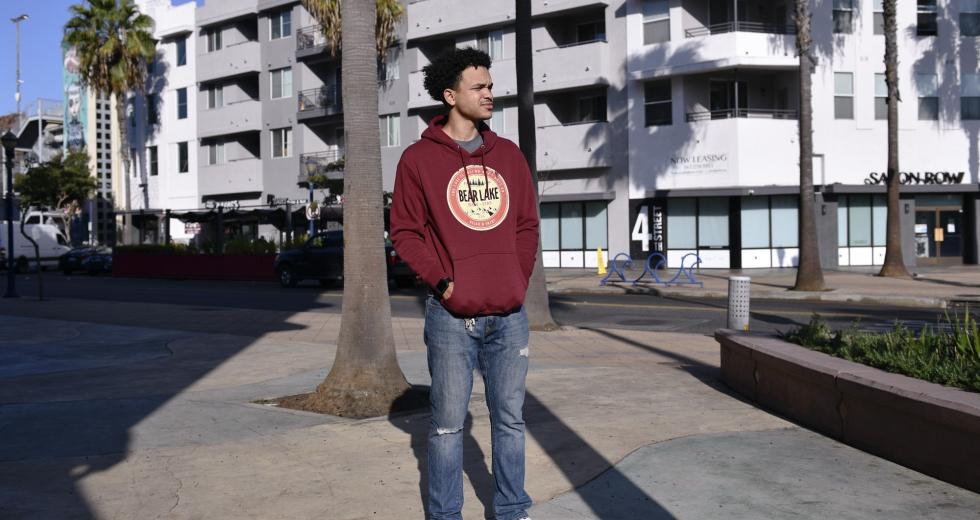David Lewis was just a few credits shy of earning his associate’s degree in journalism from Long Beach City College when the pandemic hit.
Lewis, 29, was already encountering scheduling conflicts between his classes and a new job at Trader Joe’s. As the assignments for his online classes started to pile up, he struggled to keep pace. In March, he left school.
It was a difficult choice because he’d returned to college just months before, determined to fulfill a promise he’d made to his mother before she passed away from cancer.
“I had always told her that I was going to go back to school and finish,” he said. “So I didn’t want to lie.”
Lewis is one of thousands of California community college students who didn’t return to school this fall as the coronavirus pandemic upended their lives. Enrollment at California community colleges is down more than 9 percent from the year before, mirroring a national trend, according to a recent survey from the National Student Clearinghouse Research Center (NSCRC), which tracks enrollment trends across the country.
The data confounded the predictions of some higher education experts that community college enrollment would rise this fall, as it has in previous recessions, with the coronavirus motivating students to stay closer to home.
And it differs from the trend at the state’s four-year public universities, where enrollment has actually gone up slightly, NSCRC found.
“We thought that we would get a boost from those students who decide to stay with their local community college,” said Timothy Leong, communications director for the Contra Costa Community College District in the San Francisco Bay Area. Instead, he said, enrollment at Contra Costa College is down by almost 12 percent.
The reasons students are leaving range from financial insecurities to difficulties with online learning, community college leaders said.
“They started this pandemic already with low resources, low access to financial aid, so they didn’t have those safety nets,” said Lizette Navarette, vice chancellor for college finance at the 2.1 million-student California Community Colleges, the United States’ largest higher education system, during a recent legislative hearing. “Any job loss, changes in wages, affect them immediately.”
In previous recessions, community college enrollment has increased as people sought new skills and credentials. However, the pandemic is fundamentally different, said Julianna Barnes, president at Cuyamaca College in El Cajon.
“In previous recessions, people were incentivized to increase their skill sets,” Barnes said. “However, in this case, many people possess the skills and training they need to enter the workforce, but are simply unable to work due to the pandemic.”
Unlike four-year residential colleges, community colleges are largely commuter campuses. While this does help to prevent spread of the coronavirus, community college students are under additional layers of pressure, said Barnes.
“Many students work and help their own children with learning at home,” she said.
For student parents like Fulisha Oscar, a criminology major at Madera Community College in the Central Valley, balancing everyday tasks has become increasingly difficult during the pandemic. She’s currently taking 15 credits while raising five children and working a full-time job. Oscar says she wakes up at 3 a.m. to get started on her own coursework before her children wake up and she has to start homeschooling.
“It’s so much harder focusing at home,” she said. Online learning, she said, “merges your school and home together and it’s hard to separate the two when they’re in the same environment.”
Higher education experts worry that if community college students like Oscar don’t get the support they need to continue learning during the pandemic, more of them may drop out and never return.
That could create a ripple effect at four-year campuses, decreasing the number of students obtaining bachelor’s degrees and forestalling economic mobility, said Audrey Dow, senior vice president at the non-profit Campaign for College Opportunity.
“The loss of two to five years of students who didn’t earn degrees should really be devastating to our economy and health of our state,” she said.
“I feel like I’m not living. I feel like I’m surviving.”
Devan Estrada, Computer Science Major, San Joaquin Delta College
Adrián Trinidad, a fellow at the University of Southern California’s Center for Urban Education who studies educational equity, said there could be fewer students of color enrolled at four-year universities in the future if community college students don’t transfer.
“Community colleges have historically been a place for Black, Brown, Latino, and Indigenous populations to enter the gateway to higher education,” he said.
Some of the steepest enrollment drops have been at rural colleges and among Black and Native American students.
Already impoverished rural communities are reeling from high COVID-19 infection and unemployment rates. Rural colleges also have smaller populations to draw from compared to their urban counterparts, so it’s difficult to offset enrollment drops with expanded recruitment.
Nationally, Native American and Alaskan Native community college students had the highest drop-out rate this fall at 9.6 percent, while Black students had the second highest at 7.5 percent, according to the NSCRC.
At Woodland College near Sacramento, overall enrollment dropped by 5 percent this fall, but Native American enrollment is down by a quarter, from 49 students to 37.
“There are several issues at play, including but not limited to, technology insecurities like laptop and wifi issues, increased workloads, increased needs to support siblings with distance learning and the overall impact of the pandemic on communities of color,” said Lisceth Brazil-Cruz, the interim dean of institutional effectiveness.
International student enrollment at some community colleges has plummeted, too, due to immigration restrictions, visa delays, and travel bans. Foothill College, DeAnza College, Santa Monica College and Orange Coast College are among the top community colleges nationwide for international students, who can pay more than three times as much in tuition as in-state students.
The Foothill-De Anza Community College District projects a 20 percent drop in international student enrollment for the 2020-21 school year, which will cost the district an estimated $5 million. Together, Foothill and DeAnza host around 3,600 international students.
Jordan England, the executive director of international student programs at the district, said that the presence of international students on campus is about much more than the money.
“We will always be working to retain these students because they are so important to the colleges,” she said. “They are the part and parcel to the fabric of the communities of both colleges and have been for decades.”
Some of the community college enrollment drop that individual colleges are reporting came from students who didn’t drop out entirely, but scaled back the number of credits they were taking.
Devan Estrada, a computer science major at San Joaquin Delta College, lost her job at a clothing store in the local mall when COVID-19 hit. She began working 48 hours a week at a warehouse, which left her with little time to manage a full-time courseload. So she dropped classes, pushing back her graduation.
The pandemic forced other changes, too: Estrada’s grandmother, who she had been living with, was diagnosed with leukemia and moved to avoid exposure to COVID-19, leaving Estrada and her brother with nowhere to go.
“We had to leave immediately and we couldn’t afford to pay for the house,” she said. “We were struggling pretty bad to find a place.”
Estrada has since found housing, but said covering the cost of her education remains a struggle, and she just doesn’t have time to be a full-time student..
“I feel like I’m not living. I feel like I’m surviving,” she said.
To boost retention, community colleges have looked for ways to help students stay focused on their education. These include late-start classes, online tutoring, virtual mental health services, efforts to address food insecurity, and support programs targeting students of color.
Foothill College created a second spring schedule with a later start to classes for students who might still need to earn a few credits in order to graduate. At rural Shasta College, where enrollment has fallen by 15 percent compared with last year, administrators switched from a semester to a quarter system for some hands-on courses, like science labs, and doubled its lab sections to allow busy students to complete courses more quickly.
Imperial Valley College identified food and housing insecurity as some of the biggest challenges affecting students’ ability to stay in school during the pandemic, said president Martha Garcia. Students are struggling to afford even basic school supplies like paper, notebooks, and pencils, Garcia said. Imperial County, on the Mexican border, has by far the highest rate of COVID-19 hospitalizations in the state, at 34 per 100,000 people. About 90 percent of students at the college identify as Hispanic or Latino, one of the communities affected most by COVID-19.
The college has distributed food to students through contactless delivery services, Garcia said, and community members donated 12 RVs for students to live in during the pandemic. The college is also applying for funding to build 26 tiny homes near campus.
Still, enrollment at Imperial College has fallen by 14 percent this fall.
“At the end of the day, I would love to have retained the enrollment but it cannot be at the cost of our students’ safety,” said Garcia. “I want the students here to succeed. And if this learning environment is not conducive to them, then we need to try to adapt as we move forward. And meet them where they’re at, not them meet us where we assume they should be.”
A few community colleges have bucked the downward trend. At Cuyamaca College, enrollment has stayed relatively steady, with the number of continuing students actually up by 10 percent.
The college’s large amount of open land allows more students to safely study outside on campus, Barnes said. Cuyamaca has expanded both its food distribution and mental health services, she said. The Umoja Scholars and Pathways Academy programs provide mental, emotional and academic support for Black and Latino students, both demographics who have been particularly impacted by the pandemic.
A $100 million donation made to the California Community Colleges last month could help colleges support low-income students during the pandemic. The largest donation ever given to a community college system, the grant from the Jay Pritzker Foundation will start by giving up to $150,000 this year to each of 34 colleges in the Central Valley, the Inland Empire, and rural northern California, regions with the lowest percentages of adults with college degrees. The colleges will spend the money on emergency aid to students, with the option to fund larger scholarships in future years.
The goal is that students in those regions stay enrolled full-time and graduate, said Eloy Ortiz Oakley, the system’s chancellor. “We want the colleges to leverage that against other means of aid to help students when they first get to college.”
Lewis, the former Long Beach City College student, said he plans to return to school within a year, whether or not in-person learning has resumed.
“I do feel a little bit left out and left behind. And I don’t want to wait so long that other things come up,” he said.
In the past nine months, he has continued to work, while spending time with his siblings and looking into investing in real estate with the inheritance left by his mother. He plans to finish his associate’s degree, and said he might pursue a bachelor’s if he can afford it.
“It’s like a return on my investment,” he said. Right now, I’ve invested so much, and I’ve gotten little to nothing. I haven’t gotten what I wanted out of it.”
Hall is a fellow with the CalMatters College Journalism Network, a collaboration between CalMatters and student journalists across California. Kazenoff is a contributor to the network. Charlotte West contributed reporting. This story and other higher education coverage are supported by the College Futures Foundation.
CalMatters.org is a nonprofit, nonpartisan media venture explaining California policies and politics.
–
Stay up to date on the effects of the coronavirus on people and business in the Capital Region: Subscribe to the Comstock’s newsletter today.
Recommended For You

Winnie Comstock-Carlson
Publisher
Winnie Comstock-Carlson is the president and publisher of Comstock’s magazine. She launched the publication in 1989 and is still going strong.

Virtual Variations
With the coronavirus pandemic forcing most college classes online, recent high school graduates are finding their choices have changed
Students are weighing all the options, including attending community college, learning online or postponing college altogether.

Learning to Pivot
New college grads are adapting to an economy and job market hard hit by the coronavirus pandemic
As college seniors finished their classes online, the impact of the coronavirus pandemic complicated their job prospects.

The COVID-19 Pandemic Has Made the Education Process More Challenging
Comstock’s president and publisher considers the difficulty of starting a new school year in the midst of the pandemic.



